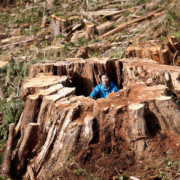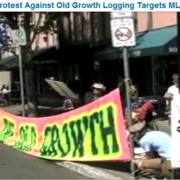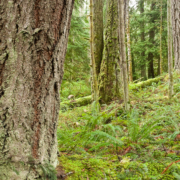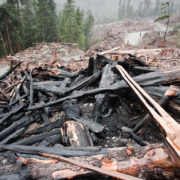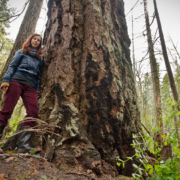Old-growth forest ‘a sea of stumps’
Massive stumps found on Crown land near Port Renfrew are arousing fears that logging companies are taking the biggest and best old-growth trees — at the same time as the local chamber of commerce is trying to promote giant-tree tourism.
Old-growth red cedar stumps, measuring 3.7 to 4.6 metres in diameter and cut in the last few months, were found in the Gordon River Valley, near a huge stand of old-growth trees nicknamed Avatar Grove, by members of the Ancient Forest Alliance.
“People need to understand the urgency of the situation,” said Ken Wu, co-founder of the alliance.
“Globally rare ancient forests are being turned into a sea of giant stumps and tree plantations.”
John Cash, Port Renfrew Chamber of Commerce president, said it’s disappointing that old-growth logging is accelerating just as the Pacific Marine Circle Route — a paved road connecting Port Renfrew to Lake Cowichan — is being promoted as a scenic tourist attraction.
“Even on that road they didn’t allow a buffer, so it’s clearcut right up to the edge of the road. I get comments about it all the time,” he said.
Tourists want to see big trees and Port Renfrew has some of the biggest, Cash said, but long-term benefits for the community are being sacrificed for short-term profit for logging companies.
“It’s like open warfare here,” he said. “If the forest companies had been responsible to begin with and had done their planting and management properly, there would be no need to cut down old-growth forests.”
The largest stumps found by the Alliance were on land being logged by Surrey-based Teal-Jones Group, which also has cutting rights for part of Avatar Grove, although the company has not yet applied for a permit.
A Teal-Jones spokesman did not return calls yesterday.
Forests Minister Pat Bell said there is no shortage of old-growth on Vancouver Island, which constitutes 900,000 hectares of the 1.9 million hectares of Crown land. “It represents a significant part of the Island,” Bell said.
Vancouver Island also has 438,000 hectares in protected areas and parks, many of which include old-growth forests. In the area around Port Renfrew, 19,000 hectares are protected in old-growth-management areas, he said.
“I think there’s a good balance there already, but it is always worth looking at specific sites,” he said.
The Alliance is asking the government to inventory and protect old-growth forests where they are scarce and to ensure sustainable logging of second-growth forests.
Bell said forest companies are already shifting to second growth.
But the Alliance is notching up the PR battle with the launch of a Facebook competition called Canada’s Biggest Stumps, where members can upload photos of the largest tree stumps they find.
“With relatively few eyes and ears out there monitoring what is going on in our forests, photo expeditions and competitions like this will help to show the public what serious environmental destruction is happening just down the backroads,” said Alliance co-founder TJ Watt.

